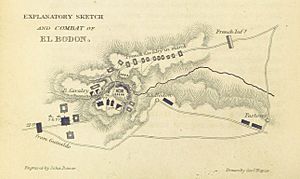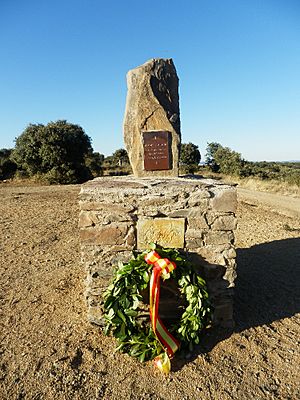Battle of El Bodón facts for kids
Quick facts for kids Battle of El Bodón |
|||||||
|---|---|---|---|---|---|---|---|
| Part of the Peninsular War | |||||||
 A map of the battle |
|||||||
|
|||||||
| Belligerents | |||||||
| Commanders and leaders | |||||||
| Strength | |||||||
| Unknown | 1,500 | ||||||
| Casualties and losses | |||||||
| Unknown | 27 killed 92 wounded 22 missing |
||||||
The Battle of El Bodón was a short but important fight during the Peninsular War. It happened on September 25, 1811, near the village of El Bodón in Spain. In this battle, a smaller group of British and Portuguese soldiers bravely held off much larger French cavalry forces, even though the French had infantry support. It's known as a "rearguard action" because the British and Portuguese were protecting their main army as it moved back.
Why the Battle Happened
After an earlier fight called the Battle of Fuentes de Oñoro, the French army left the northern border of Portugal. The Duke of Wellington, who led the British and Portuguese forces, then surrounded the city of Ciudad Rodrigo. This was to stop supplies from getting in or out.
In September 1811, a French commander named Marshal Marmont gathered a huge army. He had about 60,000 foot soldiers and 5,000 cavalry (soldiers on horseback). His goal was to break the siege around Ciudad Rodrigo.
The Fight Begins
When the French army got close, the British soldiers guarding the area pulled back. This allowed the French to resupply Ciudad Rodrigo. Wellington's main base was at Fuenteguinaldo, about 9 kilometers (6 miles) behind Ciudad Rodrigo.
A group of British soldiers, the 2nd battalion of the 5th Foot, was protecting Wellington's headquarters. They were told to move forward and help two groups of Portuguese artillery (cannons) and some cavalry. These troops were about 3 kilometers (2 miles) from Ciudad Rodrigo.
About 3 kilometers (2 miles) east of this spot was El Bodón village. The British Third Division, led by Sir Thomas Picton, was there. The Light Division was positioned between El Bodón and the Águeda River.
Major Henry Ridge of the 2nd/5th Foot was in charge of his unit. He didn't know if he should retreat if attacked or fight to the end. So, he set up guards to prevent a surprise attack. At dawn, he saw many French cavalry coming out of Ciudad Rodrigo and crossing the river.
There were two roads from Ciudad Rodrigo. One was better for cannons and was to the right of Major Ridge's position. The other went right through where his soldiers were. It was hard to tell which way the French would come because of the hilly ground. Major Ridge prepared his cannons and lined up his soldiers on a high ridge.
Holding the Line
As the French cavalry got closer, their target became clear. The Portuguese cannons started firing at the French. Just then, the Duke of Wellington arrived. He quickly looked around and told Major Ridge he liked his plans. Wellington promised to send cavalry to help.
But before Wellington could move far, a large group of French cavalry attacked. For a moment, they captured the cannons. However, the 2nd/5th Foot fired their guns steadily and then charged with bayonets. They got the cannons back and pushed the French away.
Soon, Major General Charles Colville arrived with more allied soldiers. These included the British 77th Foot and the 21st Portuguese regiment. He took command of the allied force, which was now about 1,500 strong. They held their position for three hours. The French cavalry attacked them many times, and French cannons fired heavily.
Finally, the French infantry (foot soldiers) moved forward. The allied soldiers had to retreat. The ground they retreated over was good for cavalry. So, the allied soldiers formed into "squares" (a defensive formation where soldiers stand in a square facing outwards). The French cavalry charged these squares repeatedly, but they couldn't break through.
During this time, the French also tried to cut off the Light Division. But Major General Robert Craufurd cleverly moved his troops across the Águeda River. This saved the division, and they retreated in good order.
After the Battle
After the battle, the Duke of Wellington set up a new position in front of Guinaldo. But this spot wasn't easy to defend, so he moved his army again the next day. They took up a strong position behind a river called the Cob. The French army only had enough supplies for ten days. Because of this, they had to pull back. After the French left, the British and Portuguese army moved back to almost the same places they were before the attack.
Wellington was very proud of his troops' actions at El Bodón. He issued a special order praising them. He highlighted the bravery and discipline of the 2nd battalion of the 5th Foot, the 77th Foot, the 21st Portuguese regiment, and the Portuguese artillery. He also praised the 11th Light Dragoons and the 1st Hussars.
Wellington noted that the Portuguese artillery soldiers fought until they were cut down at their guns. He praised the 5th regiment for retaking the cannons and the 77th regiment for fighting off cavalry. He said the cavalry, though outnumbered, charged many times and even captured prisoners.
He explained that he ordered the troops to retreat only because the French infantry was joining the fight, making it too unequal. He praised how the troops retreated in good order, forming squares that the French cavalry could not break. Wellington said this battle was a great example of what "steadiness, discipline, and confidence" can achieve. He wanted all soldiers in the army to learn from this example. He also personally thanked the commanders involved, including Major General Colville, Major General Alten, Lieutenant Colonel Cummins, Lieutenant Colonel Arenschild, Lieutenant Colonel Broomhead, Major Ridge, and Colonel Bacellar.


